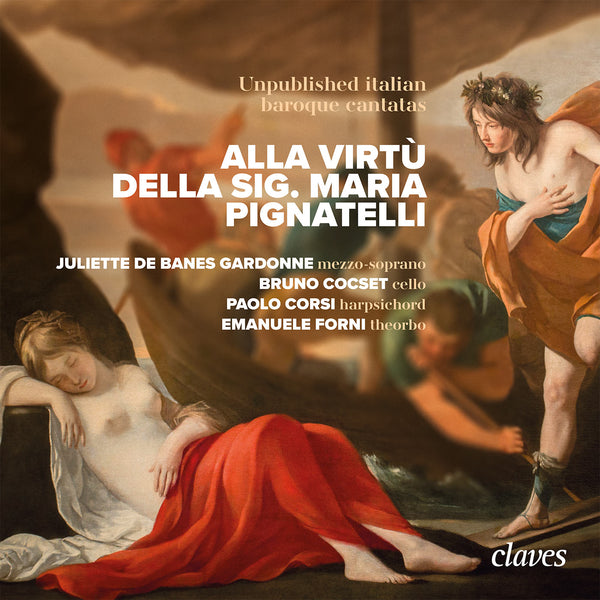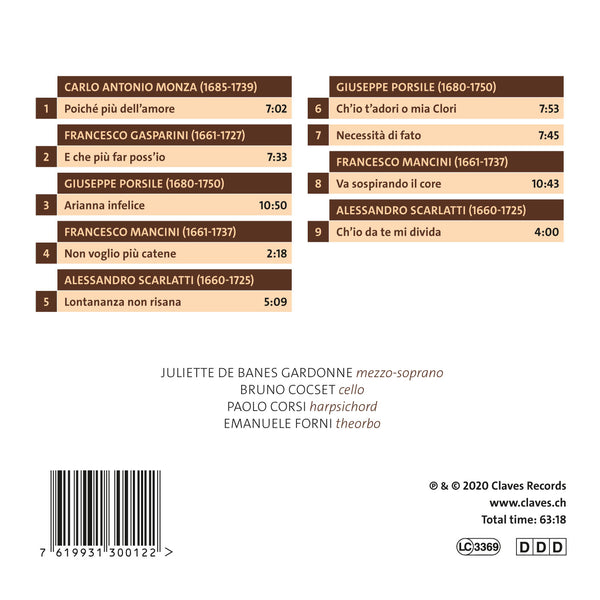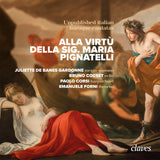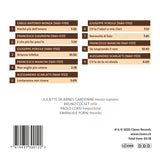(2020) Alla Virtù della Sig. Maria Pignatelli - Unpublished italian baroque cantatas
Kategorie(n): Operngesang Raritäten
Instrument(e): Violoncello Cembalo
Gesangsstimme(n): Mezzo-soprano
Hauptkomponist: Giuseppe Porsile
CD-Set: 1
Katalog Nr.:
CD 3001
Freigabe: 18.12.2020
EAN/UPC: 7619931300122
Dieses Album ist jetzt neu aufgelegt worden. Bestellen Sie es jetzt zum Sonderpreis vor.
CHF 18.50
Dieses Album ist nicht mehr auf CD erhältlich.
Dieses Album ist noch nicht veröffentlicht worden. Bestellen Sie es jetzt vor.
CHF 18.50
Dieses Album ist nicht mehr auf CD erhältlich.
CHF 18.50
Inklusive MwSt. für die Schweiz und die EU
Kostenloser Versand
Dieses Album ist nicht mehr auf CD erhältlich.
Inklusive MwSt. für die Schweiz und die EU
Kostenloser Versand
Dieses Album ist jetzt neu aufgelegt worden. Bestellen Sie es jetzt zum Sonderpreis vor.
CHF 18.50
Dieses Album ist nicht mehr auf CD erhältlich.
This album has not been released yet.
Pre-order it at a special price now.
CHF 18.50
Dieses Album ist nicht mehr auf CD erhältlich.
CHF 18.50
Dieses Album ist nicht mehr auf CD erhältlich.
SPOTIFY
(Verbinden Sie sich mit Ihrem Konto und aktualisieren die Seite, um das komplette Album zu hören)
ALLA VIRTÙ DELLA SIG. MARIA PIGNATELLI - UNPUBLISHED ITALIAN BAROQUE CANTATAS
AN ENIGMATIC MANUSCRIPT
The Antoniana Library in Padua holds a manuscript called Cantate alla virtù della Signora Maria Pignatelli. A true vocal anthology of the early 18th century, this period canzoniere contains forty-eight secular cantatas, almost all unpublished, by seventeen composers from the great artistic centres that Italy had around 1700: Rome and the Papal States (Bologna, Ferrara, Ravenna), the Duchy of Milan, Naples, the Kingdom of Sicily, and Venice.
The manuscript contained (among other things) three questions that we were able to work on thanks to research funded by the HEM (University of Music) in Geneva and the IRMAS (Institut recherche Musique et Art de la Scène - Institute of Research on Music and Scenic Arts): 1) who was the dedicatee of the manuscript, 2) who could have been the author of the compilation, 3) when was the compilation made.
Originating from the ancient Kingdom of Naples, the Pignatelli family was one of the most illustrious families in Italy. It was divided into many branches, and it is on the Spanish side that our research brought new evidence as to the identity of Maria Anna Pignatelli (1689-1755)12. A native of Alcudia, Maria Anna Pignatelli is remembered for her love affair with the poet and librettist Pietro Metastasio as the second “Metastasian” Marianna. In 1709 she married Count Johann-Michael Von Althann in Barcelona and followed her husband to the Austrian court. A favourite of the Archduke Charles V, she was behind the success of Metastasia in Vienna, whom she brought in to replace Apostolo Zeno. Given this identity, the compilation cannot be dated after 1709, when Maria Anna was known as Countess of Althan, whereas the title of the manuscript only indicates the term Signora Pignatelli.
GIUSEPPE PORSILE, MAIN COMPOSER OF THE MANUSCRIPT
With eight cantatas, the Neapolitan Giuseppe Porsile is the most represented composer in the manuscript. Numerous biographical inaccuracies have long perpetuated a rather blurred image of this musician, of whom only one composition from his early Neapolitan period is known, the dramma per musica Il ritorno d’Ulisse alla patria (1707). Porsile was officially appointed Kapellmeister in Barcelona on January 1, 1708, and his career is troubling because it follows that of Maria Anna Pignatelli in a similar manner from Barcelona to Vienna. One of our research theories is that Porsile himself wrote this canzoniere for Maria Pignatelli, shortly before the young woman’s marriage.
With eighteen cantatas written by Neapolitan composers or composers considered as such (eight by Giuseppe Porsile, two by Francesco Mancini, five by Alessandro Scarlatti and three by Domenico Scarlatti), the manuscript seems closely linked to the city of Naples. Nine composers are associated with the city of Bologna (Benati, Albergati, Cesarini, Bononcini, Gasparini, Arresti, Pistocchi, Perti, and Monza). The first three were in the service of the Roman Cardinal Benedetto Phamphilj who, from 1690 to 1693, was Cardinal Legate there. The other six were members of the Philharmonic Academy of the city. Cesarini was to follow his patron to Rome, where he was to meet up with Alessandro Scarlatti, Gasparini and Bononcini. The latter, after passing through London, was to spend the rest of his life in Vienna. The Tuscan Orlandini travelled between Florence and the Philharmonic Academy of Bologna. Finally, Gasparini, Pollaroli and D. Scarlatti mainly worked in Venice.
CHOICE OF CANTATAS
For this CD, we tried to preserve the identity of the manuscript, especially the Neapolitan musical predominance. We therefore featured three cantatas by G. Porsile, each of which has a musical or literary characteristic trait: the evocation of a tarantella in Ch’io t’adori oh mia Clori; an instrumental introduction “à la française” in Necessità di Fato, and a reference to the myth of Ariadne in Arianna infelice. In response to Ariadne’s suffering and to her vow of faithfulness which concludes Porsile’s cantata, we extracted the aria of a cantata by F. Mancini called Non voglio più catene, voglio la libertà (I want no more chains, I want freedom). Also by Mancini, Va sospirando il core is one of the cantatas that can be found in many collections. This multiplicity testifies to the fame of certain arias at the time. A. Scarlatti naturally appears in this Neapolitan part of the CD with the cantata Lontananza non risana recorded on a tenor viol. The final aria from the cantata Se ti lascio amato bene for cello and voice features in the manuscript under the composer’s name “Di Fiorenza”. However, this is a mistaken attribution in favour of Alessandro Scarlatti, which we were able to bring to light through our research. All these Neapolitan cantatas were recorded on a harpsichord by Augusto Bonza (1984) after Guarracino (17th-century Neapolitan harpsichord maker).
Two other cantatas in the manuscript caught our attention: Poiché più dell’amore, by the Milanese Carlo Antonio Monza, whose vocal music remains extremely poorly known. Despite his Lombardy origins, Monza’s musical output can be traced back to the cities of central and southern Italy between 1709 and 1724; and the cantata E che più far poss’io by Francesco Gasparini, one of the most important Italian opera composers of the first three decades of the 18th century. They were recorded on Paolo Corsi’s historic harpsichord built by Elpidio Gregori (central Italy) around 1760.
Juliette de Banes Gardonne
FRA
UN MANUSCRIT ÉNIGMATIQUE
À la bibliothèque Antoniana de Padoue est conservé un manuscrit intitulé Cantate alla virtù della Signora Maria Pignatelli. Véritable anthologie vocale du début du XVIIIe, ce canzoniere d’époque contient quarante-huit cantates profanes, presque toutes inédites, par dix-sept compositeurs issus des grands foyers de création que l’Italie comptait vers 1700 : Rome et États pontificaux (Bologne, Ferrare, Ravenne), duché de Milan, Naples, Royaume de Sicile, Venise.
Le manuscrit renfermait (entre autres) trois énigmes sur lesquelles nous avons pu travailler grâce à une recherche financée par la HEM de Genève et l’IRMAS (Institut recherche Musique et Art de la Scène) : 1) qui était la dédicataire du manuscrit, 2) qui pouvait être l’auteur de la compilation, 3) à quelle date a-t-elle été réalisée.
Originaire de l’ancien royaume de Naples, la famille Pignatelli est l’une des plus illustres lignées d’Italie. Divisée en de nombreuses branches, c’est du côté de la branche espagnole que nos recherches ont permis d’apporter de nouvelles preuves en faveur de l’identité de Maria Anna Pignatelli (1689-1755). Native d’Alcudia, Maria Anna Pignatelli passa à la postérité par son histoire d’amour avec le poète et librettiste Pietro Metastasio en tant que seconde Marianna « Métastasienne ». Elle épousa en 1709 le Comte Johann-Michael Von Althann à Barcelone et suivi son mari à la cour d’Autriche. Favorite de l’archiduc Charles V, elle est à l’origine du succès de Métastase à Vienne qu’elle fit venir pour remplacer Apostolo Zeno. En considérant cette identité, la compilation ne peut être postérieure à 1709, date après laquelle Maria Anna porte le nom de comtesse d’Althan, alors que le titre du manuscrit indique uniquement le terme de Signora Pignatelli.
GIUSEPPE PORSILE, COMPOSITEUR REPRÉSENTATIF DU MANUSCRIT
Avec huit cantates, le napolitain Giuseppe Porsile est le compositeur le plus représenté du manuscrit. De nombreuses inexactitudes biographiques ont longtemps perpétuées une image assez floue de ce musicien, dont on ne connaît qu’une seule composition de sa première période napolitaine, le dramma per musica Il ritorno d’Ulisse alla patria (1707). Officiellement nommé le 1er janvier 1708 maitre de chapelle à Barcelone, la trajectoire de Porsile est troublante car elle suit celle de Maria Anna Pignatelli de manière concordante de Barcelone à Vienne). Une de nos hypothèses de recherche est que Porsile lui-même aurait réalisé ce canzoniere pour Maria Pignatelli, peu avant le mariage de la jeune femme.
CHOIX DES CANTATES
Pour ce disque, nous avons cherché à conserver l’identité du manuscrit notamment la prédominance musicale napolitaine. Ainsi figurent trois cantates de G.Porsile dont chacune présente une particularité musicale ou littéraire : l’évocation d’une tarentelle dans Ch’io t’adori oh mia Clori; une introduction instrumentale « à la française » dans Necessità di Fato, une référence au mythe d’Ariane dans Arianna infelice. En réponse à la souffrance d’Ariane et à son voeu de fidélité qui conclue la cantate de Porsile, nous avons isolé l’air d’une cantate de F. Mancini intitulée Non voglio più catene, voglio la libertà (je ne veux plus de chaines, je veux la liberté). De Mancini également, Va sospirando il core est l’une des cantates que l’on retrouve dans de multiples fonds. Cette multiplicité témoigne de la notoriété de certains airs à l’époque. A. Scarlatti apparait naturellement dans cette partie napolitaine du disque avec la cantate Lontananza non risana enregistrée avec une viole ténor. L’air final tiré de la cantate Se ti lascio amato bene pour violoncelle et voix, figure dans le manuscrit sous le nom du compositeur « Di Fiorenza ». Cependant, il s’agit d’une erreur d’attribution en faveur d’Alessandro Scarlatti, que nous avons pu mettre en lumière par nos recherches. Toutes ces cantates napolitaines ont été enregistrées sur un clavecin d’Augusto Bonza (1984) d’après Guarracino (facteur de clavecin napolitain du XVIIe).
Deux autres cantates du manuscrit ont retenu notre attention : celle du milanais Carlo Antonio Monza Poiché più dell’amore dont la musique vocale reste extrêmement peu connue. Malgré ses origines lombardes, la production musicale de Monza peut être retracée entre 1709 et 1724 jusqu’aux villes du centre et du sud de l’Italie. La cantate E che più far poss’io de Francesco Gasparini, l’un des plus importants compositeurs d’opéra italiens des trois premières décennies du XVIIIe siècle. Elles ont été enregistrées sur le clavecin historique de Paolo Corsi construit par Elpidio Gregori (Italie centrale) vers 1760.
Juliette de Banes Gardonne
(2020) Alla Virtù della Sig. Maria Pignatelli - Unpublished italian baroque cantatas - CD 3001
AN ENIGMATIC MANUSCRIPT
The Antoniana Library in Padua holds a manuscript called Cantate alla virtù della Signora Maria Pignatelli. A true vocal anthology of the early 18th century, this period canzoniere contains forty-eight secular cantatas, almost all unpublished, by seventeen composers from the great artistic centres that Italy had around 1700: Rome and the Papal States (Bologna, Ferrara, Ravenna), the Duchy of Milan, Naples, the Kingdom of Sicily, and Venice.
The manuscript contained (among other things) three questions that we were able to work on thanks to research funded by the HEM (University of Music) in Geneva and the IRMAS (Institut recherche Musique et Art de la Scène - Institute of Research on Music and Scenic Arts): 1) who was the dedicatee of the manuscript, 2) who could have been the author of the compilation, 3) when was the compilation made.
Originating from the ancient Kingdom of Naples, the Pignatelli family was one of the most illustrious families in Italy. It was divided into many branches, and it is on the Spanish side that our research brought new evidence as to the identity of Maria Anna Pignatelli (1689-1755)12. A native of Alcudia, Maria Anna Pignatelli is remembered for her love affair with the poet and librettist Pietro Metastasio as the second “Metastasian” Marianna. In 1709 she married Count Johann-Michael Von Althann in Barcelona and followed her husband to the Austrian court. A favourite of the Archduke Charles V, she was behind the success of Metastasia in Vienna, whom she brought in to replace Apostolo Zeno. Given this identity, the compilation cannot be dated after 1709, when Maria Anna was known as Countess of Althan, whereas the title of the manuscript only indicates the term Signora Pignatelli.
GIUSEPPE PORSILE, MAIN COMPOSER OF THE MANUSCRIPT
With eight cantatas, the Neapolitan Giuseppe Porsile is the most represented composer in the manuscript. Numerous biographical inaccuracies have long perpetuated a rather blurred image of this musician, of whom only one composition from his early Neapolitan period is known, the dramma per musica Il ritorno d’Ulisse alla patria (1707). Porsile was officially appointed Kapellmeister in Barcelona on January 1, 1708, and his career is troubling because it follows that of Maria Anna Pignatelli in a similar manner from Barcelona to Vienna. One of our research theories is that Porsile himself wrote this canzoniere for Maria Pignatelli, shortly before the young woman’s marriage.
With eighteen cantatas written by Neapolitan composers or composers considered as such (eight by Giuseppe Porsile, two by Francesco Mancini, five by Alessandro Scarlatti and three by Domenico Scarlatti), the manuscript seems closely linked to the city of Naples. Nine composers are associated with the city of Bologna (Benati, Albergati, Cesarini, Bononcini, Gasparini, Arresti, Pistocchi, Perti, and Monza). The first three were in the service of the Roman Cardinal Benedetto Phamphilj who, from 1690 to 1693, was Cardinal Legate there. The other six were members of the Philharmonic Academy of the city. Cesarini was to follow his patron to Rome, where he was to meet up with Alessandro Scarlatti, Gasparini and Bononcini. The latter, after passing through London, was to spend the rest of his life in Vienna. The Tuscan Orlandini travelled between Florence and the Philharmonic Academy of Bologna. Finally, Gasparini, Pollaroli and D. Scarlatti mainly worked in Venice.
CHOICE OF CANTATAS
For this CD, we tried to preserve the identity of the manuscript, especially the Neapolitan musical predominance. We therefore featured three cantatas by G. Porsile, each of which has a musical or literary characteristic trait: the evocation of a tarantella in Ch’io t’adori oh mia Clori; an instrumental introduction “à la française” in Necessità di Fato, and a reference to the myth of Ariadne in Arianna infelice. In response to Ariadne’s suffering and to her vow of faithfulness which concludes Porsile’s cantata, we extracted the aria of a cantata by F. Mancini called Non voglio più catene, voglio la libertà (I want no more chains, I want freedom). Also by Mancini, Va sospirando il core is one of the cantatas that can be found in many collections. This multiplicity testifies to the fame of certain arias at the time. A. Scarlatti naturally appears in this Neapolitan part of the CD with the cantata Lontananza non risana recorded on a tenor viol. The final aria from the cantata Se ti lascio amato bene for cello and voice features in the manuscript under the composer’s name “Di Fiorenza”. However, this is a mistaken attribution in favour of Alessandro Scarlatti, which we were able to bring to light through our research. All these Neapolitan cantatas were recorded on a harpsichord by Augusto Bonza (1984) after Guarracino (17th-century Neapolitan harpsichord maker).
Two other cantatas in the manuscript caught our attention: Poiché più dell’amore, by the Milanese Carlo Antonio Monza, whose vocal music remains extremely poorly known. Despite his Lombardy origins, Monza’s musical output can be traced back to the cities of central and southern Italy between 1709 and 1724; and the cantata E che più far poss’io by Francesco Gasparini, one of the most important Italian opera composers of the first three decades of the 18th century. They were recorded on Paolo Corsi’s historic harpsichord built by Elpidio Gregori (central Italy) around 1760.
Juliette de Banes Gardonne
FRA
UN MANUSCRIT ÉNIGMATIQUE
À la bibliothèque Antoniana de Padoue est conservé un manuscrit intitulé Cantate alla virtù della Signora Maria Pignatelli. Véritable anthologie vocale du début du XVIIIe, ce canzoniere d’époque contient quarante-huit cantates profanes, presque toutes inédites, par dix-sept compositeurs issus des grands foyers de création que l’Italie comptait vers 1700 : Rome et États pontificaux (Bologne, Ferrare, Ravenne), duché de Milan, Naples, Royaume de Sicile, Venise.
Le manuscrit renfermait (entre autres) trois énigmes sur lesquelles nous avons pu travailler grâce à une recherche financée par la HEM de Genève et l’IRMAS (Institut recherche Musique et Art de la Scène) : 1) qui était la dédicataire du manuscrit, 2) qui pouvait être l’auteur de la compilation, 3) à quelle date a-t-elle été réalisée.
Originaire de l’ancien royaume de Naples, la famille Pignatelli est l’une des plus illustres lignées d’Italie. Divisée en de nombreuses branches, c’est du côté de la branche espagnole que nos recherches ont permis d’apporter de nouvelles preuves en faveur de l’identité de Maria Anna Pignatelli (1689-1755). Native d’Alcudia, Maria Anna Pignatelli passa à la postérité par son histoire d’amour avec le poète et librettiste Pietro Metastasio en tant que seconde Marianna « Métastasienne ». Elle épousa en 1709 le Comte Johann-Michael Von Althann à Barcelone et suivi son mari à la cour d’Autriche. Favorite de l’archiduc Charles V, elle est à l’origine du succès de Métastase à Vienne qu’elle fit venir pour remplacer Apostolo Zeno. En considérant cette identité, la compilation ne peut être postérieure à 1709, date après laquelle Maria Anna porte le nom de comtesse d’Althan, alors que le titre du manuscrit indique uniquement le terme de Signora Pignatelli.
GIUSEPPE PORSILE, COMPOSITEUR REPRÉSENTATIF DU MANUSCRIT
Avec huit cantates, le napolitain Giuseppe Porsile est le compositeur le plus représenté du manuscrit. De nombreuses inexactitudes biographiques ont longtemps perpétuées une image assez floue de ce musicien, dont on ne connaît qu’une seule composition de sa première période napolitaine, le dramma per musica Il ritorno d’Ulisse alla patria (1707). Officiellement nommé le 1er janvier 1708 maitre de chapelle à Barcelone, la trajectoire de Porsile est troublante car elle suit celle de Maria Anna Pignatelli de manière concordante de Barcelone à Vienne). Une de nos hypothèses de recherche est que Porsile lui-même aurait réalisé ce canzoniere pour Maria Pignatelli, peu avant le mariage de la jeune femme.
CHOIX DES CANTATES
Pour ce disque, nous avons cherché à conserver l’identité du manuscrit notamment la prédominance musicale napolitaine. Ainsi figurent trois cantates de G.Porsile dont chacune présente une particularité musicale ou littéraire : l’évocation d’une tarentelle dans Ch’io t’adori oh mia Clori; une introduction instrumentale « à la française » dans Necessità di Fato, une référence au mythe d’Ariane dans Arianna infelice. En réponse à la souffrance d’Ariane et à son voeu de fidélité qui conclue la cantate de Porsile, nous avons isolé l’air d’une cantate de F. Mancini intitulée Non voglio più catene, voglio la libertà (je ne veux plus de chaines, je veux la liberté). De Mancini également, Va sospirando il core est l’une des cantates que l’on retrouve dans de multiples fonds. Cette multiplicité témoigne de la notoriété de certains airs à l’époque. A. Scarlatti apparait naturellement dans cette partie napolitaine du disque avec la cantate Lontananza non risana enregistrée avec une viole ténor. L’air final tiré de la cantate Se ti lascio amato bene pour violoncelle et voix, figure dans le manuscrit sous le nom du compositeur « Di Fiorenza ». Cependant, il s’agit d’une erreur d’attribution en faveur d’Alessandro Scarlatti, que nous avons pu mettre en lumière par nos recherches. Toutes ces cantates napolitaines ont été enregistrées sur un clavecin d’Augusto Bonza (1984) d’après Guarracino (facteur de clavecin napolitain du XVIIe).
Deux autres cantates du manuscrit ont retenu notre attention : celle du milanais Carlo Antonio Monza Poiché più dell’amore dont la musique vocale reste extrêmement peu connue. Malgré ses origines lombardes, la production musicale de Monza peut être retracée entre 1709 et 1724 jusqu’aux villes du centre et du sud de l’Italie. La cantate E che più far poss’io de Francesco Gasparini, l’un des plus importants compositeurs d’opéra italiens des trois premières décennies du XVIIIe siècle. Elles ont été enregistrées sur le clavecin historique de Paolo Corsi construit par Elpidio Gregori (Italie centrale) vers 1760.
Juliette de Banes Gardonne
Return to the album | Read the booklet | Composer(s): Giuseppe Porsile | Main Artist: Juliette de Banes Gardonne














